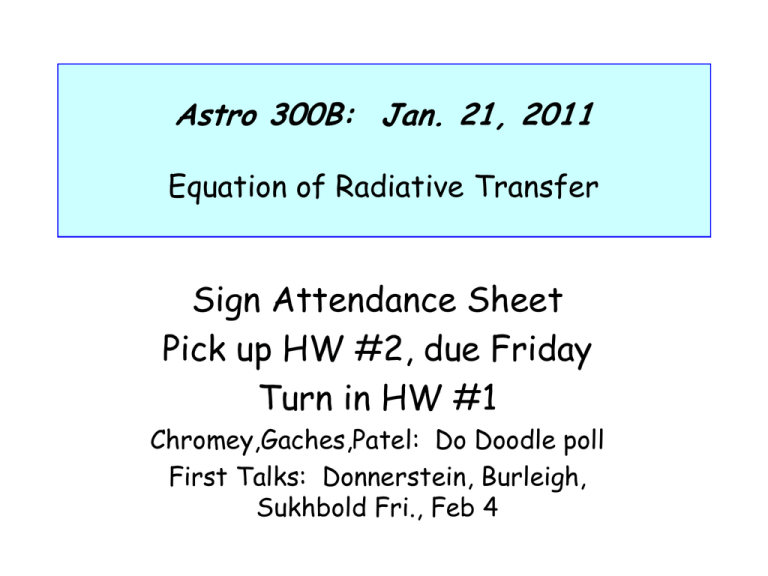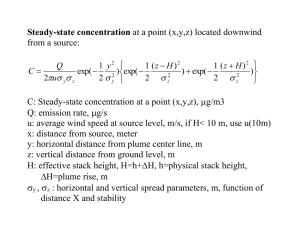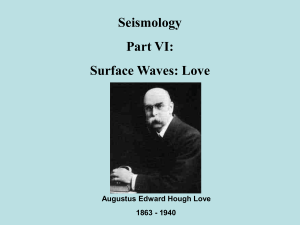Jan21
advertisement

Astro 300B: Jan. 21, 2011 Equation of Radiative Transfer Sign Attendance Sheet Pick up HW #2, due Friday Turn in HW #1 Chromey,Gaches,Patel: Do Doodle poll First Talks: Donnerstein, Burleigh, Sukhbold Fri., Feb 4 Radiation Energy Density specific energy density u uν = energy per volume, per frequency range Consider a cylinder with length ds = c dt c = speed of light dA uν(Ω) = specific energy density per solid angle Then ds dE = uν(Ω) dV dΩ dν energy Hz steradian volume energy vo steradian l Hz But dV = dA c dt for the cylinder, so dE = uν(Ω) dA c dt dΩ dν Recall that dE = Iν dA dΩ dt dν so…. I u () c Integrate uν(Ω) over all solid angle, to get the energy density uν u u d 1 I d c Recall so 1 J 4 u 4 0 4 J c I d ergs cm-3 Hz-1 Radiation Pressure of an isotropic radiation field inside an enclosure What is the pressure exerted by each photon when it reflects off the wall? Each photon transfers 2x its normal component of momentum photon + p┴ in out - p┴ 2 2 p I d cos c 2 2 p I cos d c Since the radiation field is isotropic, Jν = Iν 2 2 p J cos d d c sin 2 Integrate over 2 J d cos sin d 2π steradians c 0 0 only Not 2π 2 J c cos 3 0 3 4 1 J c 3 But, recall that the energy density So…. 4 J c u p 1 u 3 Radiation pressure of an isotropic radiation field = 1/3 of its energy density Example: Flux from a uniformly bright sphere (e.g. HII region) θ P R θc r At point P, Iν from the sphere is a constant (= B) if the ray intersects the sphere, and Iν = 0 otherwise. F I 2 c 0 0 cos d B d co sin s d R 1 where sin c r And…looking towards the sphere from point P, in the plane of the paper dφ So we integrate dφ from 2π to 0 Fν Or…. = π B ( 1 – cos2 θc ) = π B sin2 θc 2 R F B r Note: at r = R F B Equation of Radiative Transfer When photons pass through material, Iν changes due to (a) absorption (b) emission (c) scattering ds Iν + dIν Iν + dIν = dIν - dIν Iν added by emission - - dIν sc Iν subtracted by scattering Iν subtracted by absorption EMISSION: dIν+ DEFINE jν = volume emission coefficient dI j ds jν = energy emitted in direction Ĩ per volume dV per time dt per frequency interval dν per solid angle dΩ Units: ergs cm-3 sec-1 Hz-1 steradians-1 Sometimes people write emissivity εν = energy emitted per mass per frequency per time integrated over all solid angle So you can write: or d j E d d d V d t d dE dt d dV 4 Mass density Fraction of energy radiated into solid angle dΩ dI ABSORPTION Experimental fact: dI I ds Define ABSORPTION COEFFICIENT such that = d I I d s has units of cm-1 Microscopic Picture N absorbers / cm3 Each absorber has cross-section for absorption has units cm2; is a function of frequency I dI I ASSUME: (1) Randomly distributed, independent absorbers (2) No shadowing: 1 / 3 m inte cl dis ea N e 1 / 2 Then N dA ds Total area presented by the absorbers = N dA ds Total # absorbers in the volume = So, the energy absorbed when light passes through the volume is dE I N dA ds d dt d In other words, d I I d s d I N I ds N is often derivable from first principles Can also define the mass absorption coefficient Where ρ = mass density, ( g cm-3 ) Sometimes has units cm2 g-1 is denoted So… the Equation of Radiative Transfer is d I d I d I j d s I ds OR d I j I ds emission absorption Amount of Iν removed by absorption is proportional to Iν Amount of Iν added by emission is independent of Iν TASK: find αν and jν for appropriate physical processes Solutions to the Equation of Radiative Transfer dI j I ds (1) Pure Emission (2) Pure absorption (3) Emission + Absorption d I j I ds (1) Pure Emission Only 0 So, Absorption coefficient = 0 dI j ds s ) I s ) I s )j s d s ( ( o ( s o Incident specific intensity Increase in brightness = The emission coefficient integrated along the line of sight. (2) Pure Absorption Only j 0 Emission coefficient = 0 dI I ds s I ( s ) I ( s ) exp ( s ) d s o o s incident Factor by which Iν decreases = exp of the absorption coefficient integrated along the line of sight General Solution l I(L 2) L2 I(L 1) L1 dI j I dl Multiply Eqn. 1 by Eqn. 1 l expdl And rearrange L2 l l dI I dl exp dl j exp dldl L 2 L 2 l l d dl dl dl I exp j exp L2 L2 Eqn. 2 Now integrate Eqn. 2 from L1 to L2 LHS= L 2 d I exp dl I exp dl L L L 1 2 2 L 1 L 2 l l L 1 I ( L ) I ( L ) exp dl 2 1 L 2 2 L l I ( L ) I ( L ) ex p d 2 1 L 1 So… L L L 2 2 2 I ( L ) I ( L ) exp d j l exp d d ll 2 1 L L l 1 1 L L L 2 2 2 I ( L ) I ( L ) exp d j l exp d l dl 2 1 L L l 1 1 I at L2 is equal to the incident specific intensity, decreased by a factor of I(L 1) L2 exp dl L 1 plus the integral of jν along the line of sight, decreased by a factor of L2 expdl l = the integral of αν from l to L2










